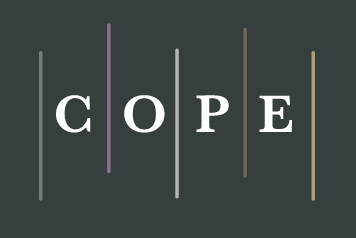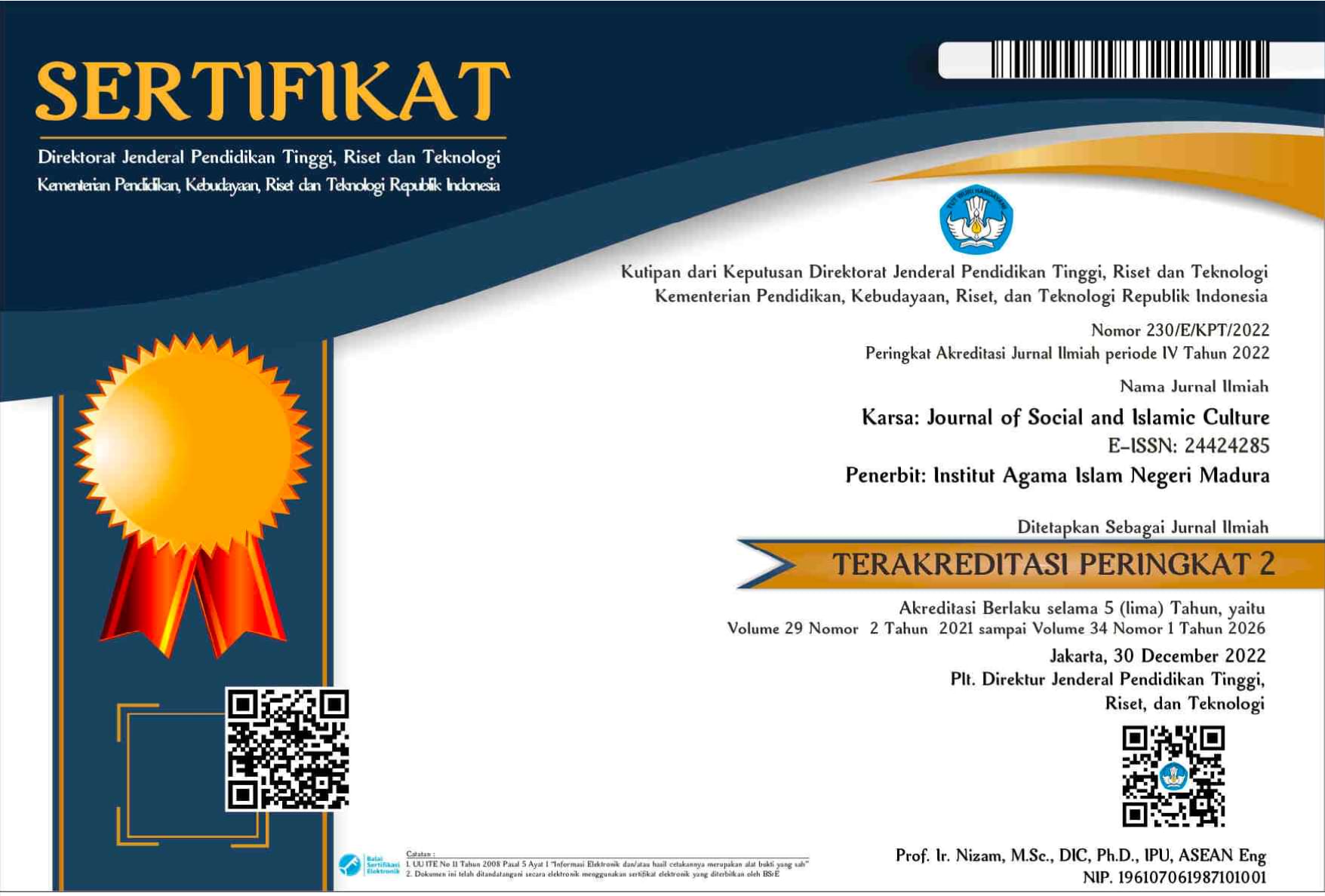Author Guidelines
The Author Guidelines of “KARSA: Jurnal Sosial dan Budaya Keislaman [Journal of Social and Islamic Culture] since the publication year of 2015 (online).
A. Introduction
KARSA (ISSN 2442-3289 and E-ISSN 2442-4285) is a peer-reviewed national journal published by Institut Agama Islam Negeri Madura. It has been nationally accredited 2012 by the General Director of Higher Education of the Ministry of Education and Culture Affairs of Republic Indonesia. It is published twice a year (June and December). It publishes articles of research results, applied theory studies, conceptual ideas, and especially concerning with social and Islamic culture issues.
KARSA: Jurnal Sosial dan Budaya Keislaman (Journal of Social and Islamic Culture) was available online since June 1st 2015. This journal was indexed in SINTA, GARUDA, Dimension, etc. The KARSA: Journal of Social and Islamic Culture editorial board invites the authors to submit their manuscript to be published in this journal.
B. How to Write the Title, the Name, and the Author’s Institution
The title of the manuscript should be written on the top of the first page with the center text alignment. Meanwhile, the author’s name (without academic degree), and the affiliation address of the author, should be written with the center text alignment also under the title of the article. The author should give two line spaces between the title and the author’s name. Then, the space between the author’s affiliation address and the abstract title is one space. The keywords must be written below the overall abstract for all words. Those should be arranged in alphabetical order and be separated by semicolon maximally three to six words. Moreover, the title of the article that is written in Indonesian should be also stated in English either (look at the example above).
The responsible author, the correspondence author, or the corresponding author must be written first and then followed by the second, the third, and so on. The communication regarding the article revision and the final statement will be informed via email to the correspondence author only. If there is more than one author, the author’s names should be written down separatedly. If the author’s name consists of at least two words, the first name should not be shorted. If the author’s names are only one word, it should be written as it is.
C. The Manuscript General Guidelines
The manuscript text general guidelines are as follows:
- The manuscript is the authentic research result that has not been published yet in other publication media or publishing houses.
- The manuscript does not contain any plagiarism element. The editorial board will directly reject the text that indicates plagiarism.
- The submission and the publication processes are free, without any additional fees.
- The manuscript that has been written under the guidelines of KARSA (in MS Word format, use this article template) must be submitted through Online Submission System using Open Journal System (OJS) on the KARSA e-journal portal (http://ejournal.iainmadura.ac.id/index.php/karsa) choose only one procedure. Then, register as one of the author or reviewer in the “Register” bottom.
- The manuscript article writing guidelines and template can be downloaded. The template and the guidelines of the article writing are available in MS Word (*.doc/*.docx) format.
- The manuscript online submission can be viewed in the part of online submission guidelines below.
- The manuscript which is inappropriate with KARSA writing guidelines will be returned to the author before the reviewing process.
- The manuscript should contain several aspects of a scientific article as follows: (subtitles as the order), which are: (a) the title of the article, (b) the author’s name (no academic title), (c) the affiliated author’s address, (d) the author’s email (e) the abstract and the keywords, (f) the introduction, (g) the research method (h), the research findings and discussion (i), the conclusion (j), the references.
- The subtitles included in the discussion part (Introduction, Methods, Result, Discussion, and Conclusion) should be numbered in the Arabic numbering order started from one. The subtitles are written in the bold and title case format. It uses the left text alignment without underline. The next expanded subtitles should be written in the bold and sentence case format, It should uses the left text alignment and the numbering format level two.
- The manuscript can be written both in Indonesian, English, French, or Arabic with the standard language. The manuscript should consist of fifteen (15) to twenty five (25) pages including pictures and tables. The article is written on A4-sized papers (210 x 297 mm), with custom margins as follows: left 40 mm, right 30 mm, bottom 30 mm and top 40 mm.
- The text of the articles must be in Times New Roman font, 12pt font size, 1 line-spacing, not separated into two columns but one column (including for the main title, the author’s name, and the abstract) with the space between columns 10 mm.
- The words from uncommon or foreign languages are stated in Italic format. Each paragraph started 11 mm from the left side border while there is no spaces among paragraphs. All numbers are written in Arabic numbering format, except for the new sentence.
- The tables and pictures are placed in the text group after the referenced tables or pictures. Each picture must be given a caption (Figure Caption) below the picture and be numbered in Arabic numbering format followed by the picture title. Each table must be given a table title (Table Caption) and numbered in Arabic numbering format above the table followed by the table title. The pictures attachment should be guaranteed that they can be printed well (font size, resolution and line space are clearly seen). The picture, the table, and the chart should be placed in the center between text groups. If it has a bigger size, it can be placed in the center of page. The table should not contain vertical lines, while horizontal lines are allowed only for the important point.
D. The Guidelines for the Manuscript Body Text
The title of the manuscript: The title should be informative and be written both briefly and clearly. It cannot diverse multi interpretations. It has to be pinpoint with the issues that will be discussed. The beginning word is written in the capital case and symmetrically. The article title does not contain any uncommon abbreviation. The main ideas should be written first and followed then by its explanations. The article title should be written within twelve words, 12pt-sized font (Times New Roman), with the bold selection and in the center text format. Meanwhile, the abstract has to be written within 250 words maximum and followed by with three to six keywords.
Introduction: The introduction must contain (shortly and consecutively) a general background and a literature review (state of the art) as the basic of the brand new research question, statements of the brand new scientific article, main research problems, and the hypothesis. In the final part of the introduction, the purpose of the article writing should be stated. In the scientific article format, it does not allow to write down the references as in the research report. They should be represented in the literature review to show the brand new of the scientific article.
Methods: The method is implemented to solve problems, including analytic methods. The methods used in the problem solving of the research are explained in this part.
Result: The results section is the most important part of the abstract and nothing should compromise its range and quality. The results section should therefore be the longest part of the abstract and should contain as much detail about the findings as the journal word count permits. Here the researcher presents summarized data for inspection using narrative text and, where appropriate, tables and figures to display summarized data. Only the results are presented. No interpretation of the data or conclusions about what the data might mean are given in this section. The text describes the data presented in the tables and figures and calls attention to the important data that the researcher will discuss in the Discussion section and will use to support Conclusions. The results section describes experiments that were completed before the paper was written. Therefore, the simple past tense is the natural choice when describing the results obtained. Think of the results section of your research article as answering the question “What?”—What did you find? This section, typically written in a descriptive fashion, reports on your findings. Save the analysis for the discussion section that follows.
Best practices:
- Clearly communicates key findings with no or minimal interpretive comment
- Provide sufficient detail to justify any conclusions you draw later.
- Report most significant or general results first, then work toward more specific data.
- Group results in categories • Include only those data that are relevant to the discussion that follows; raw data can be placed in an appendix.
- Note estimates of margins of error in your data.
- Use visual devices to capture complex information or depict trends or comparisons.
Discussion: This part consists of the research is how they are discussed. The discussion obtained from the research have to be supported by sufficient data. In the discussion section, the past tense is generally used to summarize the findings. But when you are interpreting the results or describing the significance of the findings, the present tense should be used. Often, a combination of both the past and the present tense is used in sentences within the discussion section. You may also need to use the future tense in the discussion section if you are making recommendations for further research or providing future direction. Example: The methods reported here will open up avenues for further research in the field. The discussion section answers the question “So what?” Here, you make a case for the significance and value of your work by analyzing your results and showing how they can help you support your assertion or claim about the problem that you are addressing. This section also discussions the implications and relevance of your study and places your work in the context of an ongoing disciplinary conversation. Think of the introduction and discussion sections as the “bookends” that frame your study.
Best practices:
- Thorough analysis and interpretation of results in light of questions that prompted your study. Be sure to clarify whether results confirm or refute initial hypothesis.
- Discusses implications of work and its significance; suggests further research.
- Accounts for difficulties and challenges in the research, and problems in the research design. Note limitations of your approach
- Clarifies how your work fits into the ongoing discussions of your field.
Conclusion: This is the final part containing conclusions and advices. The conclusions will be the answers of the hypothesis, the research purposes and the research discoveries. The conclusions should not contain only the repetition of the results and discussions. It should be the summary of the research results as the author expects in the research purposes or the hypothesis. The advices contain suggestions associated with further ideas from the research.
Bibliography: All the references that used in the article must be listed in this part. In this part, all the used references must be taken from primary sources (75% from all the references) that published in the last ten years. Each article should has at least ten references.
E. The Guidelines for the Citations and References
Author may cite several articles from KARSA: Journal of Social and Islamic Culture. All the served data or quotes in the article taken from the other author articles should attach the reference sources. The references should use a reference application management such as Mendeley or Zotero. The writing format that used in KARSA: Journal of Social and Islamic Culture follows the format applied by Chicago Manual Citation Style: 17th Ed. If you would like to inquire about the suitability of a proposed piece prior to full submission please submit an abstract or a draft copy of your manuscript for brief feedback. Manuscripts can be submitted using any citation style but, if accepted for publication, they must conform to Notes-Bibliography System (NB) of the Chicago Manual of Style, 17th edition. Click here for a short version of the Chicago Manual of Style guidelines. For more detailed Chicago Manual of Style guidelines, visit the Manual’s homepage.
The word count not should be clearly indicated. All submissions must be in .doc or .docx format to facilitate the peer-review process. All manuscripts must be published in English (with correctly grammar), but dual copies in other languages can be considered simultaneously upon request by the author. We actively encourage this multi language format (alike English, Indonesia, Arabic, or French). The journal aims to inform potential contributors of a decision within around three months. Decisions by the peer-review/editorial team are final.
F. The Guidelines for the Literature Reviews
The literature reviews should use a reference application management such as Mendeley or Zotero. The writing format that used in KARSA: Journal of Social and Islamic Culture follows the format applied by Chicago Manual Citation Style.
G. The Online Submission Manuscript Guidelines
The manuscript text must be submitted by one of two systems (the second procedure is more preferable):
- The document should submitted by Online Submission System in the KARSA: Journal of Social and Islamic Culture e-journal portal.
- Firstly, the author should register as either an author or reviewer (checking role as author or reviewer) in the “Register”.
- After the registration step is completed, log in as an author, click in “New Submission”. The article submission stage consists of five stages, such as: (1). Start, (2). Upload Submission, (3). Enter Metadata, (4). Upload Supplementary Files, (5). Confirmation.
- In the “Start” column, chose Journal Section (Full Article), check all the checklists.
- In the “Upload Submission” Columns, upload the manuscript files in MSWord format in this column.
- In the “Enter Metadata” columns, fill in with all the author data and affiliation. Including the Journal Title, Abstract and Indexing Keywords.
- In the “Upload Supplementary Files” columns, the author is allowed to upload supplementary files, the statement letter, or any other else.
- In the “Confirmation” columns, if the data you entered are all correct already, then click “Finish Submission”.
If the author has difficulties in the submission process through the online system, please contact KARSA editorial team at WA: +628113289009 or email: jurnalkarsa@iainmadura.ac.id.
















